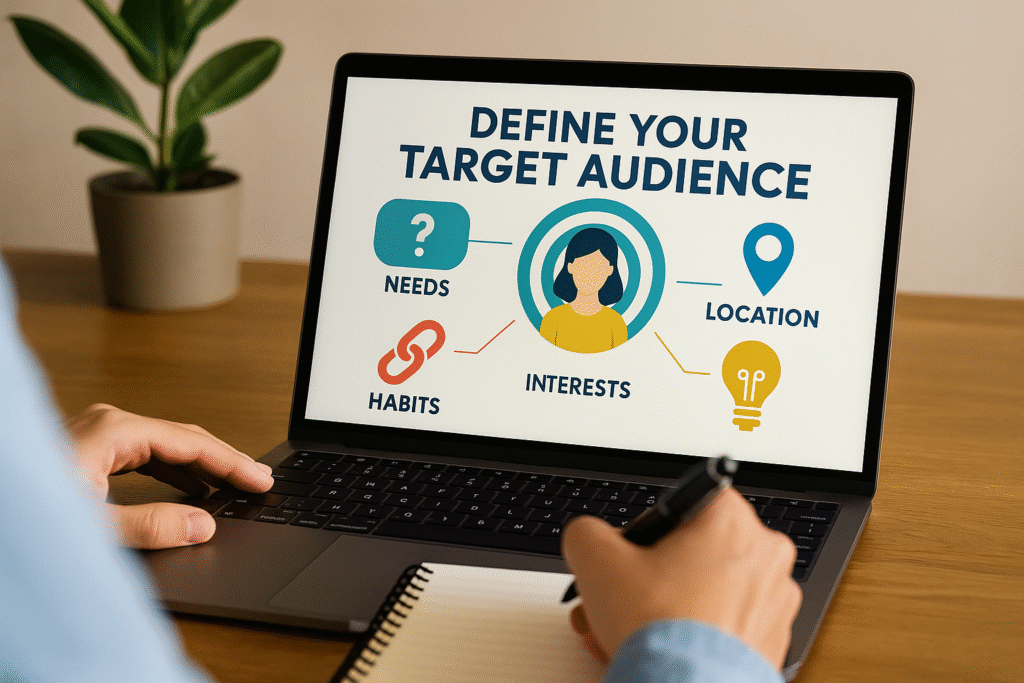One of the biggest reasons new businesses struggle is that they try to sell to everyone—and end up selling to no one. Defining your target audience is one of the most important steps in building a successful business. When you know exactly who you’re serving, you can create products, services, and marketing messages that truly connect.
In this article, we’ll show you how to clearly define your ideal customer and why it’s a game-changer for your small business.
What Is a Target Audience?
A target audience is a specific group of people who are most likely to buy your product or service. These are the individuals your business was designed to help. Understanding them allows you to:
- Speak their language
- Address their specific pain points
- Choose the right marketing platforms
- Improve your conversion rate
Instead of trying to appeal to everyone, you focus on the right people.
Step 1: Identify the Problem You Solve
Start by understanding what problem your business solves. This helps determine who actually needs your solution.
Ask yourself:
- What challenge does my product or service address?
- What desire or outcome does it help achieve?
- Who experiences this issue regularly?
Example:
If you sell eco-friendly lunch containers, the problem you solve might be plastic waste and messy food storage—your audience likely cares about sustainability and convenience.
Step 2: Gather Demographic Information
Next, define the basic characteristics of your ideal customer:
- Age range
- Gender
- Income level
- Education
- Marital status
- Occupation
- Location (local, national, or global)
Example:
You may realize your ideal customer is a 30–45-year-old working parent in an urban area with an interest in sustainability.
Step 3: Explore Psychographics
Demographics tell you who your customer is, but psychographics tell you why they buy.
Understand:
- Their values and beliefs
- Hobbies and lifestyle
- Goals and aspirations
- Pain points and frustrations
- Buying behavior (do they research a lot? Are they impulsive?)
Example:
An entrepreneur selling digital planners might target people who value productivity, hate wasting time, and love aesthetically pleasing tools.
Step 4: Create a Customer Avatar (Buyer Persona)
A customer avatar is a fictional character who represents your ideal customer. Give them a name, job, personality, and preferences.
Example:
Name: Emma
Age: 34
Job: Marketing Manager
Goals: Be more organized, eat healthy, reduce plastic use
Pain Points: Busy lifestyle, eco-guilt, wants solutions that fit her aesthetic
Spending Habits: Buys from ethical brands, shops online, reads reviews
This avatar helps you visualize who you’re talking to in your marketing.
Step 5: Study Your Existing Audience (If You Have One)
If your business is already running, use analytics and customer feedback to refine your target audience.
Tools you can use:
- Google Analytics
- Social media insights
- Customer surveys
- Email list data
Look for patterns. Who is engaging with your content? Who’s buying your product?
Step 6: Analyze Your Competitors
Find businesses with a similar offer and examine who they target:
- Who are they speaking to in their marketing?
- What kind of language and tone do they use?
- What audience are they attracting on social media?
You don’t want to copy them, but competitor research gives you clues about what’s working—and where there might be gaps.
Step 7: Use Targeting in Your Marketing Strategy
Once you know your audience, you can apply it across all areas of your business:
- Use their language in your website and ads
- Create content that solves their problems
- Choose the right platforms (Instagram, LinkedIn, TikTok, etc.)
- Offer products they truly want—not what you assume they want
Example:
If your audience is busy professionals, focus on convenience and efficiency. Highlight how your offer saves time.
Common Mistakes to Avoid
Here are a few traps new entrepreneurs fall into:
- Being too vague: “My audience is women aged 20–50” is too broad. Be specific.
- Basing assumptions on yourself: You are not your customer.
- Ignoring data: Your gut is helpful, but data is essential.
- Trying to reach everyone: Focused messages convert better.
Final Thoughts: Know Them Better Than They Know Themselves
Understanding your target audience is not a one-time task—it’s an ongoing process. The deeper your understanding, the more trust you’ll build and the easier it becomes to sell.
When you speak directly to the people you were meant to serve, your business becomes more impactful, profitable, and sustainable.
Know who you’re helping. Know how to reach them. And watch your small business grow.

